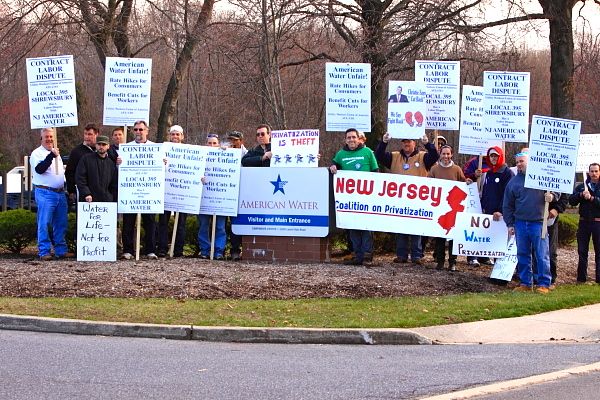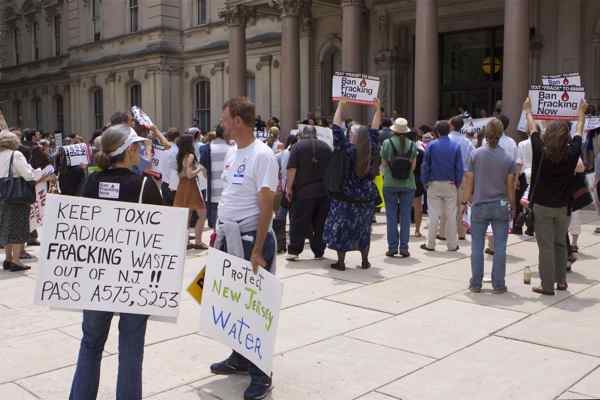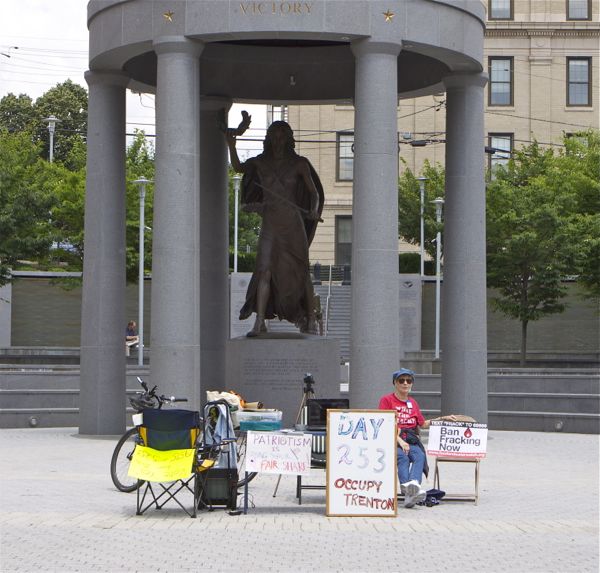Christie Administration Outsources Climate Change Adaptation Planning
Monmouth County Pipeline Collapse Illustrates Vulnerability
[Update #3 – 11/11/12- Who knew I had all this brilliant academic and theoretical backing?
While many practitioners and academics use the term sustainability instead of landscape integrity, this author is more closely aligned with Forman (2008) when he eloquently argues that, “I usually avoid the term [sustainability] as mainly being a goal reflecting each user’s agenda rather than a base of knowledge, and more to the point, it feels about as solid as sitting on a chair of jello, or toothpaste” (2008, 252; see also Conroy and Berke 2004). (@ p.3)
Update 7/5/12 – I urge readers to click on to the comments and read the response and information provided by Randy Solomon of Sustainable Jersey.]
[Updates below]
As the dust literally settles in the Monmouth County water emergency and accountability investigations begin, I thought I’d take a more detailed look at the Christie Administration’s Climate Change Adaptation Planning Program.
Amazingly, Middletown Township – the location of the pipeline collapse – has a “Sustainability Plan” application that is supposed to address infrastructure and climate change adaptation – but it doesn’t. [ The map of participating towns shows Middletown as having a certified plan.]
Even more amazingly, analysis shows that the State relies completely on this failed voluntary local process and outsources the content of the plans to a private, corporate dominated group.
So, the results are shocking, but not surprising: a massive across the board failure.
So follow the logic closely as we trace the Administration’s failures.
The performance is so consistently bad, it makes analysis and criticism like shooting fish in a barrel.
The first place I checked was NJ’s State planners at what used to be called the Office of Smart Growth (which is now promoting economic development as part off the Lt. Gov.’ “Business Action Center”).
Climate change adaptation is such a tabooed anathema to the Christie Administration that State planners can not even mention the words!
Not only is there a gag on using words to describe the concept, the State had merely delegated the entire issue to the local level and tried to shoehorn it into the pre-existing and now defunct “plan endorsement” process (which ignores infrastructure, maintenance, adaptation, and financing).
But worse, Christie’s new State Economic Development Plan eliminated cross acceptance, so planners are relying on a process that no longer exists. Here is a state planner’s explanation:
The Office of Smart Growth has been working with communities [in the plan endorsement process] to craft land use ordinances that include strategies to reduce vulnerabilities to flooding and extreme tidal flux. [Note: this is exactly what took out the bridge & pipeline in Middletown]. Specifically they are trying to reduce the amount of impervious surface along the coasts, protect wetlands and wetland buffers, and restore coastal sand dunes. Land is targeted for protection or restoration through low-resolution shape file analysis and with local guidance and suggestions. Although these measures are not explicitly labeled as climate change adaptation, these strategies will enhance the region’s resilience.
So, I then checked with DEP, the agency in charge of adaptation planning under NJ’s Global Warming Response Act.
According to a review of the NJ DEP Office of Sustainability and Green Energy, DEP has abdicated state responsibility, delegated to the local level, and outsourced adaptation planning to a corporate dominated group called “Sustainable NJ” (e.g. check their website for membership and video promotion of NJ Natural Gas).
DEP says this:
Adaptation
Despite our best efforts to reduce the greenhouse gas emissions that cause climate change, there will be permanent public health, ecological and economic impacts in New Jersey from those emissions already in the atmosphere. Scientists predict that in the coming years New Jersey will experience higher temperatures during the summer months that will result in an increase of heat-related illnesses, as well as poor air quality and short-term droughts; and more intense rain events, leaving residents susceptible to high flooding. These intense rain events will also worsen the impacts of rising sea level in New Jersey’s coastal and bayshore communities. …[Note: this is exactly why damaged the bridge and pipeline that collapsed. DEP also forgot to mention that record heat increases water demand.]
In particular, local governments, as the agents on the “front lines” during natural disasters, and as those with influence over planning and zoning decisions, need to be aware of their vulnerabilities and risks, as well as what actions they can take and where they need additional support. The Department has partnered with Sustainable Jersey to form a Climate Adaptation Task Force (CATF), which is working to determine how best to support local efforts to become resilient in the face of changing climate. The CATF released two educational tools to help local governments understand what climate adaptation is and how it will effect them. One tool is a glossary of climate-related terminology. The other tool is a New Jersey-specific climate trends and projections document. The CATF is now working to develop other risk assessment tools to support local government adaptive thinking. For more information on the CATF, visit Sustainable Jersey’s website.
So, how does DEP expect local governments to become aware of risks and vulnerabilities?
Via “Sustanable Jersey’s website you idiot!!
So, I then wandered over to check out the Sustainable Jersey website to review the content of their climate change risk assessment, municipal educational tools, and adaptation planning materials looked like. Here’s what I found:
- There is no risk assessment. None at all. Strike one.
- The “municipal tool” link went to a webpage that listed numerous BPU programs (16 in fact!). Although BPU regulates private water companies like NJ American Water (the company that was negligent in the Middletown pipe collapse) and BPU oversees and directs infrastructure maintenance and investment programs, there was nothing – nothing at all – about climate change adaptation, risk assessment, or infrastructure impacts and preventive or adaptive maintenance. Strike two.
- If one could navigate the Sustaianable NJ website, the adaptation planning material on the website led me to “Sustainable Jersey’s” certification checklist and a specific certification application submitted by Middeltown Township.
So, I then examined the certification content requirements, and found that the “Sustainable Jersey” municipal certification checklist has nothing explicit about “climate change adaptation” and neither did the “Greenhouse gas” requirements. Nothing.
However, if one scrolled down the checklist and really drilled down and clicked on the “Climate Action Plan“, one came across this one paltry and vague sentence:
A CAP includes actions to address climate change at these two different levels. Municipal actions will target improving efficiency in municipally managed facilities, infrastructure, operations, and services. Community actions will require joint efforts of the public and private sectors, and include policy changes that will affect the lives of residents and local private businesses.
First of all, the infrastructure planning is limited to “municipally managed facilities”, thus eliminating the failed bridge and pipeline that caused the problem.
Second, Middletown has not even submitted a plan. No action – No Plan.
Strike Three!
How could it get any worse?
[Update – I also checked out the governing local document – the most recent version (2009) of the Middletown Master Plan – It is silent and says nothing about “Sustainable development”.
Similarly, the Master Plan’s Utility Plan map only shows sewer infrastructure, not water supply. As the Master Plan Utility Service Element states (@ p. 36), it does not even consider water supply infrastructure:
The Utility Service Plan Element addresses stormwater management, drainage and flood control facilities, sewerage and waste treatment, and water supply and distribution facilities.
What the hell kind of local sustainable development program is that?
I will next try to document BPU regulations and policies regarding infrastructure maintenance and financing and whether those programs include climate change adaptation planning. My sense is that they do not require it and probably don’t even mention it.
BPU has programs that look relevant – Reliability and Security
The Division of Reliability and Security is responsible for implementing ongoing strategies for utility disaster preparedness, reliability and infrastructure security in conjunction with the State’s domestic preparedness and security efforts. The Division manages BPU’s response to disasters, emergency or major disruptions by the comprehensive coordination of utility remediation and recovery actions. The Division also manages two major infrastructure Safety Programs: Underground Facilities Protection Act and Pipeline Safety Program.
Here’s from BPU website on water infrastructure:
Division of Water
The Division of Water oversees the regulation of approximately 45 investor owned water and wastewater utilities. The Division mainly deals with issues such as: establishing rates for utility service; assessing water and wastewater infrastructure needs; prudency issues and related costs; ensuring a safe and reliable water supply; growth impacts on water and wastewater costs and availability; sustainability of future growth; water reuse; depletion of aquifers; service interruptions; terms and conditions of water and wastewater service and management contracts; and conservation initiatives.
The Division also deals with identifying and evaluating initiatives, programs and best practices and efforts to improve the efficient use of potable water; evaluating and analyzing conservation tariff structures and the feasibility of implementation; system integration that reduces costs and provides for increased customer benefits; and reviewing the utilities’ long-term construction plans for capital expenditure
Here is NJ American’s tariff. Cursory review suggests that these terms are relevant:
EMERGENCY RESPONSES DUE TO EXTRAORDINARY DEMAND AND/OR DIMINISHED SUPPLY (Continued)
- 4- The Company will endeavor to provide a regular and uninterrupted supply of water through its facilities. However, if because of emergencies beyond the control of the Company, including governmental mandate, service is interrupted, irregular, defective or fails, the Company will not be liable for damages or inconvenience resulting there from. In the event of an extraordinary demand and/or diminished supply, or when operational issues make such actions desirable, including, among other things, protecting the integrity of the system and permit conditions, the Company may restrict the use of water whenever the public welfare may require it and, if necessary, may shut off the water in its mains and pipes. In such cases the Company shall advise its customers by placing a prominent advertisement detailing the conditions and restrictions in a newspaper of general circulation in the utility service area. The notice will state the purpose and probable duration of the restriction or discontinuance. Failure to provide regular and uninterrupted service due to breakdowns is covered under other sections of this tariff.
- 5- The Company may restrict water service during certain periods, where the Company advises the Board of Public Utilities, in order to protect the public water supply, or otherwise to comply with any regulations, orders or decrees issued by the Governor of New Jersey or the Department of Environmental Protection, or any successor agency or department pursuant to the Water Supply Management Act, or other statutes or regulations of the state or federal government. Such interruptions or restrictions shall be reported to the Department of Environmental Protection, if necessary, and the Board by each utility by the speediest means of communications available, followed by a detailed written report, pursuant to the provisions of N.J.A.C. 14:3-3.7(e) et seq., within one week. Thereafter the utility shall provide weekly reports for the duration of the emergency.
GENERAL RULES
Here are NJ American’s duty and representations:
As the surviving entity of the Merger, New Jersey American will continue to provide safe, adequate and reliable, high-quality service consistent with its corporate history, in fulfillment of its obligations under New Jersey law, and subject to the continued jurisdiction of the Board.
Ah, but don’t worry – so what if there is no funding, no planning, and no regulation by the State Agencies with jurisdiction.
“Sustainable Jersey” has a Task Force that includes DEP and the State Climatolgist! So, you’re in good hands with All State! (hahaahah!)
[Update: You find some amazing stuff on DEP’s website – where Sustainable NJ listed as a “Business Association” and “Sustainable Business” contact, along with such environmental champions asNJ Business and Industry Assc., NJ Chamber of Commerce, and the Chemistry Council of NJ. As I indicated, this shows how Sustainable NJ is working in partnership with the Christie Administration.]





